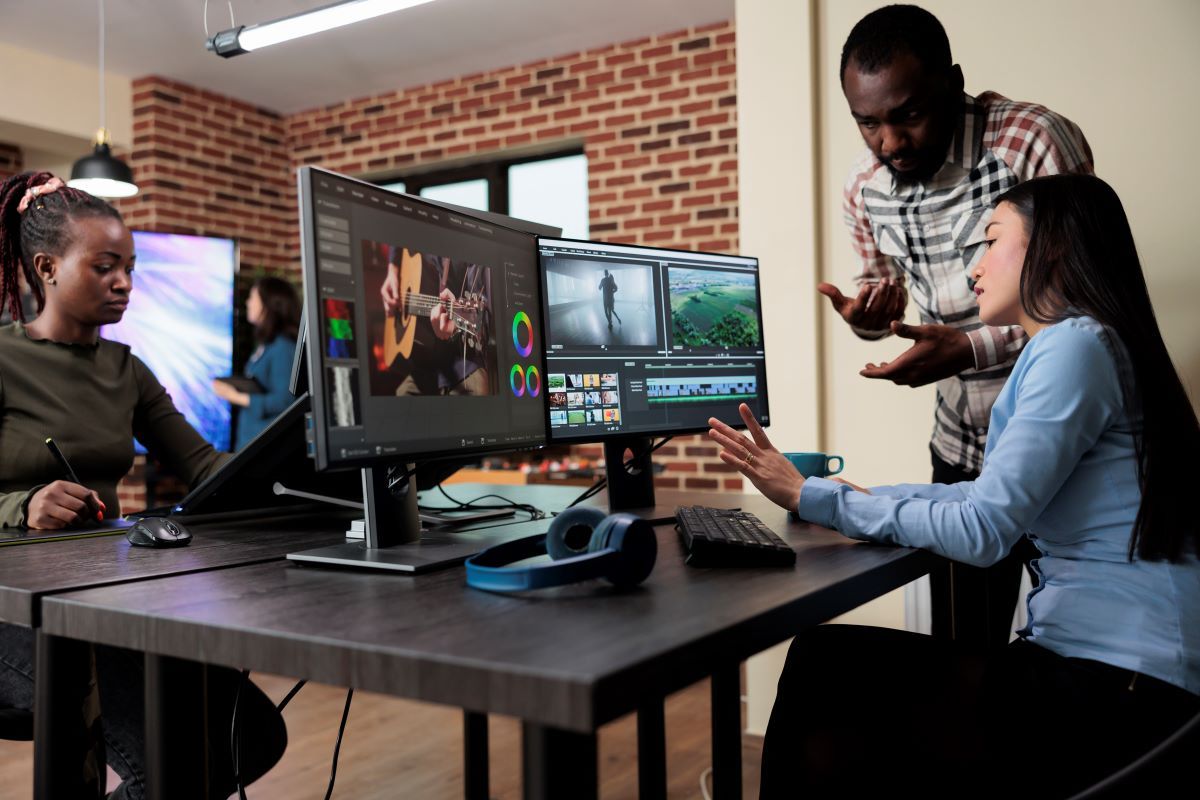Introduction
In the fast-paced world of modern filmmaking, collaboration has become the cornerstone of success. Gone are the days when directors, editors, and cinematographers had to be in the same room to get the job done. With the rise of cloud technology and creative software integration, it’s now possible for entire film teams to work seamlessly from different corners of the world.
That’s where the best collaboration tools come into play. These platforms are designed to streamline every aspect of production from planning and shooting to editing and distribution making the filmmaking process more efficient, creative, and organized.
Why 2025 Is a Landmark Year for Film Collaboration
The film industry has undergone a digital revolution in recent years. As of 2025, tools like Frame.io, Adobe Creative Cloud, and Notion have introduced AI-assisted workflows, real-time feedback features, and cross-platform integrations that make remote film collaboration faster and more intuitive than ever before.
Whether you’re an indie filmmaker managing a short film, a production studio working on a feature, or a YouTube creator crafting cinematic content, using the best collaboration tools can make the difference between chaos and creative flow.

Why Collaboration Tools Matter for Filmmakers
Collaboration is at the heart of filmmaking — every great movie is a collective effort involving writers, producers, editors, designers, and sound engineers. However, as teams become more distributed, coordinating tasks and sharing creative assets can become challenging. That’s where collaboration tools transform the filmmaking process.
1. Centralized Communication
Instead of juggling endless email threads and text messages, collaboration platforms bring all communication into one organized hub. This ensures that feedback, updates, and approvals are tracked and easily accessible.
2. Real-Time Feedback
Tools like Frame.io and Wipster allow directors and editors to leave frame-accurate comments directly on video timelines. This speeds up the editing process and eliminates confusion.
3. Cloud-Based File Sharing
High-quality film assets, often hundreds of gigabytes in size, can be securely uploaded, shared, and version-controlled through cloud collaboration tools. Platforms like Dropbox, Google Drive, and MASV make large file transfers smooth and secure.
4. Task & Project Management
Applications such as Notion, ClickUp, and Monday.com help teams assign tasks, manage schedules, and visualize production timelines.
5. AI-Powered Assistance
The new generation of collaboration tools integrates AI to help with script breakdowns, shot list generation, and even automatic transcription for dailies and interviews.
Comparison Table: Traditional vs. Modern Collaboration
| Feature | Traditional Filmmaking | Modern Collaboration Tools (2025) |
|---|---|---|
| Communication | Emails, phone calls | Real-time chat, video calls, comments |
| File Sharing | External hard drives | Cloud-based transfer & storage |
| Editing Feedback | In-person screenings | Frame-accurate online reviews |
| Task Management | Paper schedules | Interactive digital boards |
| Collaboration Scope | Local teams only | Global creative networks |

Key Features to Look For in the Best Collaboration Tools
When choosing the best collaboration tools, it’s crucial to identify what features actually make a difference for your filmmaking workflow. The ideal software should not only make your process efficient but also enhance creativity and reduce repetitive tasks.
1. Cross-Platform Compatibility
Your chosen tool should work seamlessly across devices — desktops, tablets, and smartphones — to ensure that every team member can collaborate from anywhere.
2. File Version Control
Filmmaking involves multiple versions of edits, soundtracks, and color grades. A tool that supports version history ensures no creative work is lost.
3. Integration with Popular Editing Software
Compatibility with Adobe Premiere Pro, DaVinci Resolve, or Final Cut Pro is essential for a smooth workflow.
4. Security and Permissions
Film projects are confidential intellectual properties. Tools with encryption, role-based access, and NDA support are must-haves.
5. Cloud Storage Capacity
Since high-resolution video files can be massive, prioritize tools that offer scalable storage solutions and efficient upload speeds.
6. Real-Time Collaboration
Features like simultaneous editing, shared timelines, and instant commenting allow teams to work together without delay.
7. Scalability
From indie projects to studio-level productions, the tool should be flexible enough to scale with your growing needs.
Comparison Table: Key Features of Ideal Collaboration Tools
| Feature | Why It Matters | Example Tools Offering It |
|---|---|---|
| Cross-Platform Access | Enables remote teamwork | Notion, Frame.io |
| Version Control | Prevents data loss | Google Drive, Adobe Creative Cloud |
| AI Integration | Speeds up workflows | Notion AI, Runway ML |
| Real-Time Review | Reduces turnaround time | Frame.io, Wipster |
| Security | Protects project data | Dropbox, Asana |
| Large File Support | Handles 4K/8K files | MASV, WeTransfer Pro |
Top Collaboration Tools for Filmmakers in 2025
As of 2025, filmmakers have access to an ever-growing list of digital platforms built to streamline teamwork and accelerate production pipelines. Choosing the best collaboration tools depends on your team’s size, budget, and workflow — but understanding each stage’s top software can help you build the perfect stack.
1. Pre-Production Collaboration Tools
Pre-production is the backbone of any film project — from idea development to scheduling and budgeting. The right collaboration tools can align creative vision, ensure efficient planning, and eliminate costly mistakes later in the process.
Top Tools for Pre-Production:
| Tool | Best For | Key Features | Pricing (2025) |
|---|---|---|---|
| Celtx | Scriptwriting & breakdowns | Cloud-based scripts, production calendar, budgeting tools | From $25/month |
| StudioBinder | Project organization | Call sheets, shot lists, scheduling, crew management | Free basic plan, $49/month Pro |
| Notion | All-in-one planning | Storyboarding, notes, team dashboards, AI automation | Free personal plan, $10/month Plus |
| Milanote | Visual planning | Mood boards, story mapping, creative organization | Free limited version, $12.50/month |
| Final Draft 13 | Screenwriting | Real-time collaboration, AI-assisted editing | $199 one-time license |
Pre-Production Takeaway
Using digital pre-production tools ensures that everyone — from the director to the cinematographer — works with a shared vision before filming begins. These platforms help turn ideas into structured, executable plans.

2. Production Collaboration Tools
During production, coordination between departments becomes crucial. The best collaboration tools for this phase focus on communication, file sharing, and on-set efficiency — ensuring directors, cinematographers, and crew stay synced.
Top Tools for Production:
| Tool | Best For | Key Features | Pricing (2025) |
|---|---|---|---|
| Frame.io | Real-time video sharing | On-set uploads, instant playback, commenting, version tracking | From $15/month |
| ShotDeck | Visual references | Film stills database, mood reference boards | Free plan available |
| SyncSketch | Review sessions | Live review for animation and VFX teams | From $9/month |
| Dropbox Business | File storage & transfer | 5TB storage, link sharing, collaboration permissions | From $18/user/month |
| Slack | Crew communication | Organized channels, integration with Notion, Google Drive, Zoom | Free plan, $8.75/user/month |
Production Takeaway
Production collaboration relies on clarity. When everyone can communicate and share files instantly, mistakes are reduced and creative decisions happen faster.

3. Post-Production Collaboration Tools
Post-production often involves multiple specialists — editors, colorists, VFX artists, and sound designers. This is where collaboration tools really shine, ensuring teams can work on the same project remotely without confusion or delay.
Top Tools for Post-Production:
| Tool | Best For | Key Features | Pricing (2025) |
|---|---|---|---|
| Adobe Creative Cloud | Editing & design | Shared libraries, cloud syncing, Adobe Team Projects | From $59.99/month |
| DaVinci Resolve Cloud | Professional editing | Shared timelines, color grading collaboration | $5/user/month for Cloud Collaboration |
| Frame.io | Review & approval | Time-coded feedback, version comparison | Included with Adobe CC |
| Wipster | Client review | Frame-accurate feedback, approval tracking | From $19/month |
| Soundtrap by Spotify | Audio editing | Real-time collaboration for soundtracks & podcasts | Free plan, $13/month Pro |
Post-Production Takeaway
Editing and sound work require precision. The best collaboration tools for post-production eliminate back-and-forth emails and allow teams to focus purely on creativity and quality control.

4. Communication and Project Management Tools
Even with the best technical tools, your project can fall apart without effective communication and management. These collaboration tools keep every department connected and ensure that deadlines and goals are met.
Top Communication Tools:
| Tool | Best For | Key Features | Pricing (2025) |
|---|---|---|---|
| Notion | All-in-one workspace | Notes, databases, project dashboards | Free plan, $10/month Plus |
| ClickUp | Task management | Timelines, task automation, reporting | Free plan, $12/user/month |
| Google Workspace | Collaboration ecosystem | Docs, Sheets, Drive, Meet integration | From $6/user/month |
| Microsoft Teams | Enterprise communication | Video calls, file sharing, integration with Office | Free basic plan, $5/user/month |
| Zoom | Virtual meetings | HD calls, recording, breakout rooms | Free basic plan, $14.99/month Pro |
Communication Takeaway
Good communication is the glue of any film production. Using dedicated collaboration tools ensures that your entire crew — from pre to post — stays informed and motivated.

Comparison Table: Top Collaboration Tools Summary (2025)
| Stage | Tool | Best Feature | Price (2025) | Ideal For |
|---|---|---|---|---|
| Pre-Production | Celtx | Script + Scheduling | $25/mo | Writers & producers |
| Production | Frame.io | On-set review | $15/mo | Directors & cinematographers |
| Post-Production | DaVinci Resolve Cloud | Real-time editing | $5/user/mo | Editors & colorists |
| Communication | Notion | All-in-one planning | $10/mo | Entire team |
How to Choose the Right Collaboration Tool
Choosing from the best collaboration tools can feel overwhelming — especially since each platform offers unique strengths. The key is to evaluate your filmmaking needs based on your team size, project type, and budget. Not every film requires enterprise-level software, but every project benefits from clear organization and seamless communication.
Below, we’ll go through a structured process to help you find the perfect set of tools for your filmmaking workflow.
1. Identify Your Production Stage Needs
The first step in choosing collaboration software is understanding which part of the filmmaking process requires the most coordination.
| Stage | Typical Needs | Recommended Tools |
|---|---|---|
| Pre-Production | Scriptwriting, scheduling, budgeting | Celtx, StudioBinder, Notion |
| Production | Communication, media upload, tracking shots | Frame.io, Slack, Google Workspace |
| Post-Production | Editing, review, color grading | DaVinci Resolve Cloud, Adobe Creative Cloud, Wipster |
| Marketing & Distribution | Content sharing, social collaboration | Vimeo, YouTube Studio, Asana |
Each stage has specific collaboration challenges — understanding these before committing to a tool prevents you from paying for unnecessary features.
2. Evaluate Integration Capabilities
The best collaboration tools are those that integrate seamlessly with your existing workflow. For example, if you use Adobe Premiere Pro, you’ll want tools like Frame.io or Dropbox that can embed directly into your editing timeline.
Checklist for evaluating integrations:
-
Does it connect to your editing software (Premiere, Resolve, Final Cut)?
-
Can it link with communication platforms (Slack, Notion, ClickUp)?
-
Is there an API or automation option (Zapier, Make, etc.)?
A tool that integrates across platforms reduces friction and ensures that your team doesn’t waste time switching between apps.
3. Prioritize User Experience
While features are important, usability matters more. A collaboration platform should be easy for your entire team to adopt — from tech-savvy editors to first-time assistants.
Tips:
-
Look for intuitive dashboards with clear navigation.
-
Avoid overly complex enterprise systems unless your team is large.
-
Check for mobile app versions for on-set access.
User-friendly design ensures faster onboarding and smoother collaboration overall.
4. Consider Your Budget
Your collaboration budget can range from free to thousands of dollars per month, depending on the scale of your project.
| Budget Range | Type of Tools | Example Platforms |
|---|---|---|
| Free / Low Budget | Ideal for indie creators | Notion, Milanote, Google Drive, Slack (Free) |
| Mid-Range | Best for small production teams | Frame.io, StudioBinder, ClickUp |
| Professional | For studios and agencies | Adobe Team Projects, DaVinci Resolve Cloud, Asana Business |
If you’re working on independent projects, combining free tools like Notion + Google Drive + Frame.io (Basic) can cover most production needs without breaking the bank.
5. Security and Backup Considerations
Filmmaking involves sensitive content, from unreleased scripts to proprietary footage. Before adopting any platform, confirm that it offers:
-
End-to-end encryption
-
Role-based access control
-
File recovery and backup options
-
Secure login methods (2FA or SSO)
Tools like Dropbox Business, Frame.io, and Google Workspace Enterprise are excellent choices for maintaining data integrity across distributed teams.
6. Scalability for Future Projects
Even if you’re working on small projects today, the tool you pick should grow with your ambitions. Look for:
-
Flexible user limits
-
Scalable storage
-
Multi-project management capabilities
-
API or custom integration options
If your collaboration ecosystem can scale, you’ll save time and money in future projects.
Comparison Table: How to Choose the Right Tool
| Criterion | Why It Matters | Best Tools Matching It (2025) |
|---|---|---|
| Integration | Smooth workflow across platforms | Frame.io, Notion, Google Workspace |
| Affordability | Fits indie budgets | Milanote, Notion, Slack Free |
| Real-Time Sync | Enables instant feedback | DaVinci Resolve Cloud, Wipster |
| Security | Protects assets & footage | Dropbox Business, Frame.io |
| Scalability | Grows with your studio | ClickUp, Asana, Notion |
7. Test with a Short Project First
Before committing fully, test your chosen toolset on a smaller project. Run a short film or test video using only the collaboration tools you plan to adopt. This allows your team to adapt and identify issues before scaling up.
8. Combine Tools for Maximum Efficiency
No single platform covers everything — the best approach is to combine tools that complement one another.
Example Workflow:
-
Pre-production: Notion for planning + Celtx for scripts
-
Production: Slack for communication + Frame.io for footage review
-
Post-production: DaVinci Resolve Cloud for editing + Frame.io for feedback
By integrating these platforms, filmmakers can maintain a cohesive, collaborative ecosystem from start to finish.

Workflow Example – Using Multiple Tools in a Real Film Project
Now that we’ve reviewed the best collaboration tools, let’s see how they actually fit into a real-world filmmaking workflow. This section shows how a small production team can use multiple platforms together — from pre-production to post-release — to manage a professional-quality film project remotely.
This example will help you visualize how each tool contributes to smoother coordination, faster feedback, and more creative freedom.
Scenario Overview
Let’s imagine a small indie production team working on a 15-minute short film titled Echoes of Tomorrow. The crew is spread across Los Angeles, London, and Seoul — making online collaboration essential.
Here’s how their workflow unfolds using a carefully selected combination of the best collaboration tools of 2025.
Step 1: Pre-Production (Planning and Organization)
Tools Used: Notion, Celtx, Milanote
The director starts by setting up a shared Notion workspace that acts as the digital headquarters for the project. It includes:
-
Project overview
-
Scene breakdowns
-
To-do lists for each department
-
Deadlines and milestone tracking
Meanwhile, the writer and producer collaborate on Celtx to finalize the script. Celtx’s real-time editing and AI-powered script breakdowns automatically generate a shooting schedule and budget estimates.
The art director uses Milanote to create mood boards and visual story references, helping everyone align on the film’s tone and color palette.
Result:
By the end of pre-production, every department knows what to do, when to do it, and how their tasks fit into the bigger picture.
Step 2: Production (Filming and Coordination)
Tools Used: Slack, Frame.io, Google Workspace
Once shooting begins, communication becomes the team’s lifeline. The production manager creates dedicated Slack channels for each department — #camera, #lighting, #sound, and #editing — to keep updates streamlined.
After each shoot day, the DIT (Digital Imaging Technician) uploads proxy footage to Frame.io. The director, producer, and editor can review the footage the same night and leave frame-accurate comments.
Google Workspace handles the logistics — using Google Sheets for the shooting schedule and Google Drive for script revisions and call sheets.
Result:
The entire crew stays updated in real-time, and decisions about retakes or continuity issues happen instantly — even across different time zones.
Step 3: Post-Production (Editing, Color, Sound, and Review)
Tools Used: DaVinci Resolve Cloud, Adobe Creative Cloud, Frame.io, Wipster
As the shoot wraps, the post-production team begins their collaborative work in DaVinci Resolve Cloud. Editors in Seoul and colorists in London work simultaneously on the same timeline using shared project databases.
When rough cuts are ready, they’re uploaded to Frame.io for director and producer feedback. The feedback is visible frame-by-frame, reducing confusion and saving hours of email back-and-forth.
For sound design and mix approval, the team uses Wipster, which allows timestamped audio notes and client reviews. Motion graphics and titles are completed in Adobe After Effects, synced through the Creative Cloud ecosystem.
Result:
Post-production collaboration feels like everyone’s in the same studio, even when working remotely. Review cycles shorten dramatically, and creative revisions happen faster.
Step 4: Marketing and Distribution
Tools Used: Canva, Vimeo, Notion, Asana
Once the final film is approved, the marketing team steps in. Using Canva, they create promotional posters and social media banners that match the film’s tone.
The final film is uploaded to Vimeo Pro, where private links are shared with festival curators and investors.
Back in Notion, a marketing calendar tracks social media content, press releases, and festival deadlines. For more structured campaign management, Asana handles task assignments and content scheduling.
Result:
Marketing runs in sync with production and post-production, ensuring a smooth transition from final edit to film release.
Step 5: Lessons from the Workflow
This multi-tool setup shows how filmmakers in 2025 can use the best collaboration tools not as standalone apps, but as an interconnected ecosystem.
What Worked Best:
-
Notion became the creative and managerial hub.
-
Frame.io handled review and approval efficiently.
-
DaVinci Resolve Cloud enabled global editing collaboration.
-
Slack ensured everyone stayed connected and updated.
What to Improve:
-
Using too many tools can overwhelm smaller teams.
-
Assigning a “collaboration manager” helps maintain structure and reduces tool fatigue.
Summary Table: Real-World Workflow Overview
| Stage | Tools Used | Primary Function | Outcome |
|---|---|---|---|
| Pre-Production | Notion, Celtx, Milanote | Planning, scripting, visuals | Clear project direction |
| Production | Slack, Frame.io, Google Workspace | Communication, footage sharing | Real-time feedback |
| Post-Production | DaVinci Resolve Cloud, Wipster | Editing, review, approval | Faster revisions |
| Marketing | Canva, Vimeo, Asana | Promotion, scheduling | Smooth campaign execution |
Conclusion: The Future of Filmmaking Collaboration
As filmmaking continues to evolve in the digital era, remote teamwork is no longer a challenge — it’s an advantage. From pre-production to post-release marketing, the best collaboration tools of 2025 are designed to connect storytellers, streamline workflows, and eliminate creative bottlenecks.
Filmmakers today can achieve studio-level efficiency using cloud-based tools that synchronize scripts, footage, and communication in real time. Whether you’re an indie creator working on a short film or a studio managing an international crew, the right combination of platforms — from Notion to DaVinci Resolve Cloud — can help you maintain creative control while saving time and resources.
The key is not just using the most advanced software but integrating them into a cohesive workflow that matches your production’s scale, goals, and creative needs.
Summary of the Best Collaboration Tools for Filmmakers in 2025
| Tool Name | Primary Use | Key Strengths | Ideal For |
|---|---|---|---|
| Frame.io | Video review and approval | Real-time feedback, seamless integration with Adobe Premiere | Editors, directors, producers |
| Notion | Centralized project management | Flexible workspace, custom databases, documentation | Producers, coordinators |
| Celtx | Scriptwriting and production planning | AI breakdowns, shooting schedules, collaboration | Writers, assistant directors |
| DaVinci Resolve Cloud | Collaborative editing and color grading | Multi-user projects, secure media management | Post-production teams |
| Milanote | Visual planning and mood boards | Drag-and-drop creative organization | Art directors, cinematographers |
| Slack | Team communication | Instant messaging, channel organization, integrations | All crew members |
| Wipster | Video review platform | Timestamped comments, team collaboration | Sound and post teams |
| Canva | Marketing content design | Templates, brand kits, easy export | Marketing teams |
| Vimeo Pro | Video hosting and sharing | Private links, analytics, festival submissions | Distributors, marketers |
| Asana | Task and campaign tracking | Calendar views, automation, integrations | Marketing and production management |

1. What are the best collaboration tools for filmmakers in 2025?
The best collaboration tools for filmmakers in 2025 include Frame.io for video review, Notion for project management, DaVinci Resolve Cloud for editing, Celtx for scripting, and Slack for communication. These platforms make it easier to coordinate global teams and streamline the entire production pipeline.
2. Why should filmmakers use collaboration tools?
Collaboration tools help filmmakers organize tasks, communicate efficiently, and share files in real time. They also reduce delays in production and improve creative feedback loops between directors, editors, and producers — essential for both indie and professional filmmaking.
3. Which collaboration tool is best for video editing?
For collaborative editing, DaVinci Resolve Cloud and Adobe Premiere with Frame.io are the top options in 2025. They allow multiple editors to work simultaneously on the same project and share updates instantly.
4. Can indie filmmakers benefit from these tools?
Absolutely. Most of the best collaboration tools offer free or affordable plans. Indie filmmakers can use platforms like Notion, Milanote, and Frame.io to create professional workflows without needing a massive budget.
5. How can I choose the right collaboration tools for my film project?
Start by identifying your team’s size, workflow needs, and technical comfort level. Combine one project management tool (like Notion or Asana), one communication app (like Slack), and one creative collaboration tool (like Frame.io or Wipster) for best results.
6. Are cloud-based filmmaking tools secure?
Yes, most modern tools use end-to-end encryption and secure cloud storage to protect your data. Always choose verified providers like Adobe, Blackmagic Design, or Google Workspace for sensitive media or production files.
7. What is the future of online film collaboration?
In 2025 and beyond, AI-driven automation, cloud computing, and real-time rendering will define the future of collaboration. Tools are becoming more integrated, offering all-in-one ecosystems that cover scripting, editing, and distribution in one platform.
8. How do collaboration tools improve creative decision-making?
They enable real-time feedback and instant revisions, allowing directors, editors, and producers to align on the creative vision faster. This accelerates storytelling and ensures the final cut matches the intended tone and pacing.
9. Where can filmmakers network and find collaborators online?
Filmmakers can connect through professional communities and networking sites built specifically for creatives. Check out our guide on Indie Filmmaker Networking Platforms That Actually Work to discover online spaces where you can meet talented editors, producers, and crew members for your next project.
10. What’s the biggest challenge in online film collaboration?
The main challenge is tool overload using too many apps without proper integration. The solution is to select a few of the best collaboration tools and assign clear responsibilities to maintain workflow balance and avoid confusion.
Final Thoughts
The art of filmmaking has always thrived on teamwork — and with today’s best collaboration tools, geography is no longer a limitation. From concept to release, these digital platforms empower filmmakers to focus less on logistics and more on storytelling.
Whether you’re running a small indie project or coordinating a global production, using the right combination of tools in 2025 ensures your creativity, efficiency, and collaboration remain at their highest level.


Leave a comment